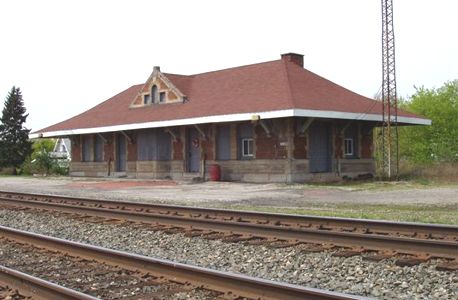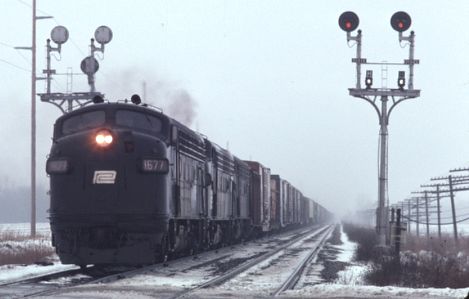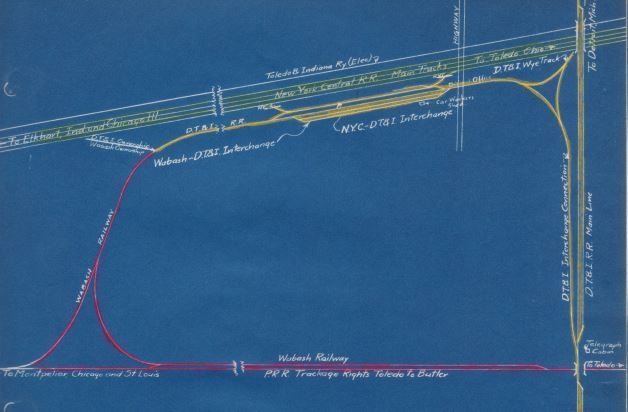- Details
- Hits: 3841
Station: Delta, OH



Photo info: Top, the former New York Central depot at Delta, Ohio. 2004. [Alan Loftis] 2nd photo, Penn Central 1677 leads a westbound train through Delta, Ohio in 1975. [Mark Hinsdale]. 3rd photo, a 1930s map of Delta with the NYC in green, DT&I in yellow and Wabash in red. The Toledo & Indiana Railway (electric) passed along the north side of the NYC. [DT&I blueprint]
Notes
The high earth fill which the DT&I sits on is nearly 8 miles long and built in the mid-1920's under Ford ownership as a part of the construction of the Malinta cut-off. The viaduct, it is said, was ordered by Henry Ford instead of a crossing diamond because Ford did not want to have any of his operations controlled by the Vanderbilt-owned New York Central. [ITI-1980-2]
The DT&I Delta yard is reached via a long sloping tangent from the viaduct over which DT&I incoming trains back down into the yard. The other feature at Delta is a large semi-circular loop track permitting eastbound N&W trains to back around into the Delta Yard. A wye off the loop enables N&W to proceed west to Montpelier about 30 miles to the west. [IT-1980-2]
Time Line
1915. Delta had a water tower. [NYCtt1915]
1930. The DT&I had a three-track interchange yard here, south of the NYC tracks. They also had a wye track for turning locomotives on the east side of their yard. The west side yard had a connection with the Wabash railway, who also had their own wye track.
1930s. At Delta the DT&I crosses overhead the branch of the Wabash which runs from Toledo to Montpelier and the main line of the New York Central between Toledo and Chicago. The latter crossing is an apex with 0.3% approach grades both north and south.
Between the two railroad separations, a track leads off the DT&I main toward the west, dropping on a 0.5% grade, to interchange tracks, where connections are made both to the Wabash and New York Central. This is the principal interchange point with the Wabash for cars moving to or from the west. The two Wabash interchange tracks have a capacity of 203 cars (later 120 cars), while the New York Central track holds 102 cars (later 50 cars).
On the east side of the DT&I main track are two passing tracks of 100-cars capacity each. Near the interchange yard, there is a wye used for turning locomotives of the "Delta turns" from Detroit. The vollage of Delta is located about two miles to the east and the DT&I has no industrial or ream tracks.
The DT&I blueprint indicates that the Wabash had a passing track here and that the Pennsylvania Railroad had trackage rights between Toledo and Butler, IN.
1930. DT&I traffic interchanged at Delta in 1930 was:
- From the Wabash: 4,974. To the Wabash: 25,606
- From the NYC: 1,691. To the NYC: 2,915
- Total Cars interchanged: From Wabash and NYC: 6,665 (18/day) - To the Wabash and NYC: 28,521 (78/day)
1980. SNAPSHOT: The DT&I operates four scheduled freights on the Delta Viaduct (or "high line") daily between 8:00 am and 4:00 pm plus a Delta turn from Flat Rock that runs nearly every day. The N&W send seasonal grain trains to Maumee and one daily freight from Montpelier to Delta for an interchange with the DT&I. The double-track Conrail main line between Toledo and Elkhart carries a great amount of traffic, both in trains and tonnage. [IT-1980-2]
2021. The major changes at Delta are 1) the Wabash railway is gone, and 2) The former DT&I (now O&I) has "ramped" interchanges both on the north and south side of what is today Norfolk Southern. Two large industries on the north side of the NS main line are North Star Bluescope Steel (east of route 10) and Worthington Steel (west of route 10). Both steel plants interchange with NS and the Ohio & Indiana railroads. Both plants also operate their own industrial railroads with switcher locomotives.
Bibliography
The following sources are utilized in this website. [SOURCE-YEAR-MMDD-PG]:
- [AAB| = All Aboard!, by Willis Dunbar, Eerdmans Publishing, Grand Rapids ©1969.
- [AAN] = Alpena Argus newspaper.
- [AARQJ] = American Association of Railroads Quiz Jr. pamphlet. © 1956
- [AATHA] = Ann Arbor Railroad Technical and Historical Association newsletter "The Double A"
- [AB] = Information provided at Michigan History Conference from Andrew Bailey, Port Huron, MI

